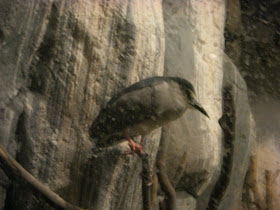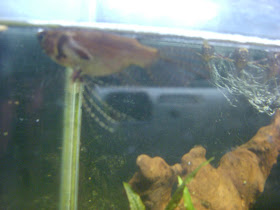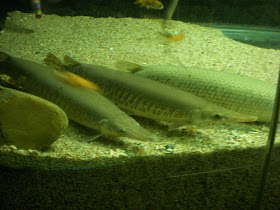The exhibits at the Taipei Zoo's nocturnal house haven't aged well over the years. Most of them are rather small, drab concrete enclosures with a few branches and other enrichment items here and there, not terribly exciting or naturalistic. Perhaps the zoo has realized this, because I hear that they have/will shut down the nocturnal house this month, to be replaced by a tropical rainforest building in the future. It's still a bit of a shame though, because I did enjoy the interesting variety of animals they kept in there, some of which I'd never seen at any other zoo.
For some reason or another the glass viewing windows didn't appear to be particularly conducive to photography, so most of these photos are rather grainy.
Here's a tytonid owl, though I forget which species exactly.
Some owl monkeys or douroucoulis, the only group of nocturnal monkeys in the world. (Once upon a time I would've said the only species of nocturnal monkey, but it is now generally thought that said taxon was overlumped and there are really many distinct species.)
A binturong, a large Asian civet that reportedly smells like popcorn.
A white-faced flying squirrel, one of the giant Asian flying squirrels. It is a local Formosan species, found at fairly high altitudes in the mountains.
A Eurasian eagle owl, one of the largest and most powerful of all owls. It commonly preys on other birds of prey, including the likes of goshawks, peregrine falcons, and buzzards.
A slow loris. It was unusually active that day, ambling and clambering around its exhibit much quicker than you'd expect for something called a slow loris. Speaking of which, it just happens to be Loris Awareness Week!
A kinkajou, one of the only two carnivorans with a prehensile tail. (The other being the aforementioned binturong.) I snapped its photo while it was grooming itself, hence the blurriness.
Nearby was a fairly close relative (maybe), one much more familiar to North Americans, the common raccoon.
A jungle cat.
A red giant flying squirrel, another species of large flying squirrel that lives in the wild here, though at lower altitudes.
Up on the second floor, there was a series of rodent exhibits that were holdovers from a special exhibition the zoo did for the Year of the Rat (2008). Most of these exhibited rodents were muroids (rats, mice, and kin), but these guinea pigs were not, being part of the same group that includes porcupines and the capybara.
A Norway rat, an albino specimen as is commonly used in laboratories and in the pet trade.
Some hamsters.
This murid was adorable, but I don't remember its name.
A black-capped night heron.
A species of hedgehog.
A Siberian weasel (the Formosan subspecies, to be exact). For a real life example of the Killer Rabbit trope, you need look no further.
A Chinese ferret badger. Unlike most other mustelids known as badgers, ferret badgers can climb trees, though considering that badgers are not a monophyletic group that probably doesn't mean anything.
An Old World porcupine from Asia. I remember it being a Malayan porcupine, so I'll go with that for now. Porcupines are also non-monophyletic, with New World and Old World taxa evolving their quilled defense convergently.
Strangely, the nocturnal house includes a number of freshwater fish exhibits, even though not all of these fish are nocturnal. These are Candidia barbata, a species endemic to Taiwan.
Paradisefish, relatives of bettas. Like bettas, they can be rather aggressive towards other fish, including their own kind.
Most of the larger fish in the nocturnal house, such as this red arowana, were kept in tanks that were clearly far too small for them, another mark of the subpar exhibit quality there.
A silver arowana. This species is well-known for their ability to jump out of the water to snatch prey from overhanging branches. It is even known to eat birds and bats.
A freshwater stingray. It lived in the same tank as the silver arowana, making the already small tank doubly crowded. I kept getting the impression that it would whip its barbed tail up to spear the arowana every time the latter brushed past it, but that didn't happen.
A bichir, part of an unusual group of air-breathing fish. They are obligate air-breathers, meaning they'd drown if denied access to air!
A freshwater butterfly fish, a surface-dwelling predatory fish with very large pectoral fins. They are good at jumping and are sometimes said to be able to glide for a short distance, though this is debated.
Some gars.
Some black ghost knifefish. Having kept a few of these for a short period of time they are among my favorite fish. The reason they are so blurry in the photo is that two of them were fighting back forth across the (really small) tank.
And if that weren't enough there was a third specimen in the exhibit.





























All these formosans make me think of Troodon...
ReplyDeleteOrnitholestes
They're derived from the same root word, after all!
DeleteEven the idea of having a silver arowana and a freshwater stingray on a small tank sounds really bad to me; I mean, as an aquarist, it's logical to say no to having two species of predatory fish on an inadequately spaced tank...
ReplyDeleteOn a slightly lighter note, I'm surprised to see that paradisefishes and bettas are that closely related (even being part of the same subfamily...)
And another surprise is to know that you're a Formosan! I thought you came from somewhere in the US XD
I didn't say I didn't come from the US... ;)
DeleteYou think your photos are bad?
DeleteI'll give you private access to a really bad water rat picture; note the wet blur..
#justmyluckatlondonzoo
http://matthewsanimals.co.uk/media/water_rat.jpg
It's a problem everyone faces in nocturnal exhibits!
DeleteWhat species was the third specimen?
ReplyDeleteAlso a black ghost knifefish.
DeleteI have 80% feeling you're female and
ReplyDelete20% feeling you're male...
I do mention my gender on a few of my online profiles, if you know where to look. But I'm curious: what makes you think that?
DeleteSo you ARE female?
ReplyDeleteWhy don't you tell me how you came to that conclusion, and I'll answer. (Or you can poke around a bit more and figure it out.) Really, I'm curious.
DeleteOK, something in my brain had a feeling all these posts were written by a female dinosaur-and-everything-before-and-after-that ethunuiast who lives somewhere near San Diego. So am I correct?
ReplyDeleteI am male, and have only been to California during vacations. But it's interesting to know what kind of image of me this blog presents.
DeleteWhat was your favourite memory?
ReplyDeleteI don't know, truth be told. I've had many good experiences; it would be hard to pick one.
Delete